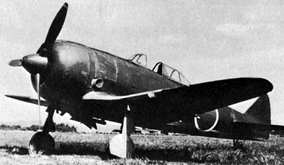The Nakajima Ki-44 Shōki was a fighter aircraft that was used by Japan during World War II.
Description[]
The first production model of the Ki-44 series was the Ki-44-Ia which had a single 1,250 hp, Nakajima Ha-41 engine that was capable of propelling it at speeds of up to 579 km/h. Its armament meanwhile consisted of two 7.7mm machine guns and two 12.7mm machine guns.[1] Notably, the wings of the Ki-44 were quite short and tapered upward at the ends.
The total weight of the Ki-44 was around 1,944 kilograms while its total length was around 8.8 meters. Wingspan meanwhile was 9.4 meters. Operational range was around 1,700 kilometers with a service ceiling of 11,200 meters.[2] The Ki-44 notably had a higher wing loading than its counterpart, the Ki-43, and thus was less maneuverable. It was sufficient though for fighting Allied aircraft such as the P-38 Lightning or P-40. However, in combat, it wasn't until the introduction of the P-51 Mustang that the Ki-44 had lost its advantages in both speed and the maneurverability it did have. Another effect of the design of the Ki-44 was a higher landing speed and trouble with handling which caused numerous accidents in landng.
Variants[]
The first variant of the Ki-44 was the Ki-44-Ib which had been reequipped with two more 12.7mm machine guns, replacing the previous 7.7mm machine guns. Next was the Ki-44-IIa which was given a new Nakajima Ha-109 engine that was capable of propelling it at speeds of up to 605 kilometers per hour. Furthermore, additional armor had been placed around the pilot's compartment and around the fuel tanks. Following came one of the more critical variants, the Ki-44-IIb which had the capability to mount two 40mm autocannons replacing two of the 12.7mm machine guns and a new gunsight. The last of the Ki-44-II series, the Ki-44-IIc, had the original 12.7mm armament returned or could mount two 20mm autocannons and the even newer Type 100 Gunsight mounted. The final variants were part of the Ki-44-III series which had a new Nakajima Ha-145 engine. The Ki-44-IIIa and Ki-44-IIIb however, were never built with the first supposed to mount four 20mm autocannons and the latter to mount two 20mm and two 37mm autocannons.
History[]
Development[]
The Ki-44 was developed by Japan in the period between 1939-1940 following combat experience gained against the Soviets in Khalkin Gol in which it was realized, that newer more modern fighters were needed to replace the aging Ki-27. To go about this, the Japanese high command had decided to create two separate fighters to accommodate two different roles that would hopefully fill the need for all Imperial Japanese Army Air Force needs in terms of fighter aircraft. They would be known as the light fighter, the Nakajima Ki-43, and the heavy fighter, the Nakajima Ki-44. Differentiating the two was that the Ki-43 was designed to be maneurverable and generally stuck closer to traditional Japanese aircraft doctrine.

A Ki-44-IIb
The Ki-44 meanwhile was quite different. It was designed to be fast and have a good climb rate, in a similar manner to contemporary Allied designs. Testing began immediately with the first model taking flight in 1940. It was tested against an imported Messerschmitt Bf 109E-3, a captured American P-40 Warhawk, a Nakajima Ki-43 Hayabusa, and a prototype Kawasaki Ki-61 Hien. While the Ki-61 had won out overall, its development was far from complete and thus the Ki-44, taking second place, had been placed into production.
Combat Service[]
The Ki-44 first entered service in December 1941 through limited service trials. Following this experience, the Ki-44 was quickly placed into service to defend the Japanese home islands from Allied bombers. The other theater that the Ki-44s had served in was the CBI theater in which it served extensively. In all, around twelve sentais or air groups used the Ki-44 during the war. When fighting against Allied bombers, the Ki-44 was initially found disappointing, requiring numerous aircraft to down a single bomber. However, as the war went on, Ki-44s became steadily far more effective, being a critical interceptor in the fight against Allied air raids. Notably, in 1945 a small group of Ki-44s managed to destroy ten B-29s. Reportedly, these had 37mm Ho-203 cannons with 25 r/g. These were effective but only small numbers equipped the 97th regiment in China, according to the Russians. [3] In total, around 1,227 examples had been produced during the war.
References[]
| |||||||||||||||||
